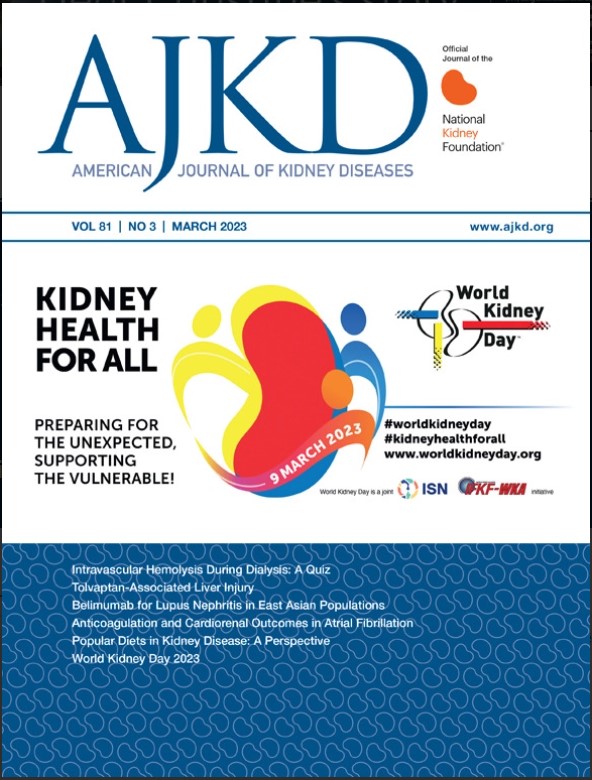Inflammatory and Cardiovascular Events in CKD: The Multi-Ethnic Study of Atherosclerosis.
IF 9.4
1区 医学
Q1 UROLOGY & NEPHROLOGY
引用次数: 0
Abstract
RATIONALE & OBJECTIVE Chronic kidney disease (CKD) is associated with a proinflammatory state caused by maladaptive immune response, predisposing to cardiovascular (CVD) and inflammatory/infectious disease outcomes. We sought to examine the association of chronic inflammation-related disease (ChrIRD) as compared to CVD events with worsening kidney function. STUDY DESIGN Longitudinal, observational study over 19 years follow-up. SETTING & PARTICIPANTS Participants free of CVD were enrolled from the Multi-Ethnic Study of Atherosclerosis (MESA), a multicenter, population-based cohort. EXPOSURE Baseline 5-level CKD categories based on modified KDIGO (Kidney Disease Improving Global Outcomes) groups using estimated glomerular filtration rate (eGFR, mL/min/1.73m2) and UACR (urine albumin-creatinine ratio, mg/g). OUTCOME(S) 3 outcomes of interest: time to occurrence of first ChrIRD, time to first CVD, and time to all-cause mortality. ChrIRD encompassed inflammatory or infectious conditions identified using ICD (except kidney codes). ANALYTICAL APPROACH Proportional hazards regression analysis RESULTS: 6,705 participants (mean age 62 years, 53% female, 38.5% White, 27.6% Black, 22% Hispanic, 11.9% Chinese) were studied. Among study participants, 70% had no CKD, 17% low-risk CKD (eGFR>60 + UACR<10-29); 7% moderate-risk CKD (eGFR ≥60 + UACR 30-299), 4.6% high-risk CKD (eGFR 30-59 + UACR <30 or eGFR 45-59 + UACR 30-299 or eGFR ≥60 and UACR ≥300), 0.8% very high-risk (more advanced combinations of eGFR/UACR). Over 19-years follow-up, unadjusted incidence density (events/1000-person-years) of ChrIRD, CVD events were (respectively): 18, 11.9 for no CKD, 26.3, 18.4 low-risk, 39.7, 29.6 moderate-risk, 60.1, 35.4 high-risk CKD and 128.7, 56.6 very high-risk categories. After demographic adjustment, respective HRs (95% CI) for ChrIRD and CVD events were 1.23 (1.10-1.39), 1.35 (1.17-1.55) for low-risk, generally increasing to 3.87 (2.75-5.44), 2.84 (1.85-4.36) for very high-risk CKD categories. LIMITATIONS Unmeasured confounders and selection bias. CONCLUSIONS ChrIRD increased in a graded fashion with worsening CKD risk categories, starting with UACR > 10 mg/g.慢性肾病的炎症和心血管事件:动脉粥样硬化的多民族研究。
理由与目的慢性肾脏疾病(CKD)与免疫反应不良引起的促炎状态相关,易导致心血管(CVD)和炎症/感染性疾病的结果。我们试图研究慢性炎症相关疾病(chrrd)与CVD事件与肾功能恶化的关系。研究设计:纵向观察性研究,随访19年。背景和参与者:无心血管疾病的受试者来自多民族动脉粥样硬化研究(MESA),这是一个多中心、基于人群的队列研究。根据肾小球滤过率(eGFR, mL/min/1.73m2)和尿白蛋白-肌酐比(UACR, mg/g)对改良的KDIGO(肾脏疾病改善总体结局)组进行基线5级CKD分类。结局(S)3个感兴趣的结局:首次发生chrrd的时间,首次发生CVD的时间,以及全因死亡率的时间。chrrd包括使用ICD识别的炎症或感染性疾病(肾脏代码除外)。分析方法:比例风险回归分析结果:6705名参与者(平均年龄62岁,女性53%,白人38.5%,黑人27.6%,西班牙裔22%,华人11.9%)。在研究参与者中,70%无CKD, 17%低危CKD (eGFR 60 + UACR 10 mg/g)。
本文章由计算机程序翻译,如有差异,请以英文原文为准。
求助全文
约1分钟内获得全文
求助全文
来源期刊

American Journal of Kidney Diseases
医学-泌尿学与肾脏学
CiteScore
20.40
自引率
2.30%
发文量
732
审稿时长
3-8 weeks
期刊介绍:
The American Journal of Kidney Diseases (AJKD), the National Kidney Foundation's official journal, is globally recognized for its leadership in clinical nephrology content. Monthly, AJKD publishes original investigations on kidney diseases, hypertension, dialysis therapies, and kidney transplantation. Rigorous peer-review, statistical scrutiny, and a structured format characterize the publication process. Each issue includes case reports unveiling new diseases and potential therapeutic strategies.
 求助内容:
求助内容: 应助结果提醒方式:
应助结果提醒方式:


